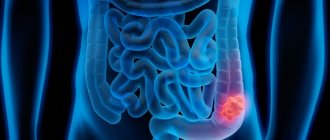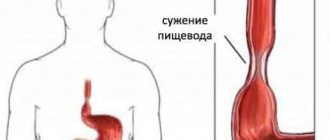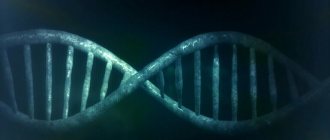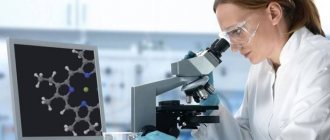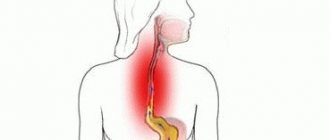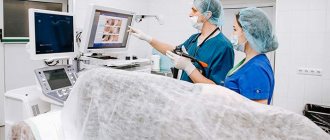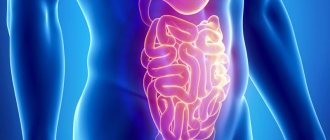Causes of intestinal adhesions
Such adhesions appear due to the ability of connective tissue to grow due to exposure to damaging factors. For example, the growth of tissue of this type can be provoked by mechanical injuries, diseases caused by acute and chronic infections, the presence of previously accumulated blood, foreign bodies, exposure to chemicals, etc. If we talk about organs located in the abdominal cavity, in particular the intestines, the causes of adhesions are most often mechanical injuries, as well as contact of the peritoneum with air during surgery. Consequently, intestinal adhesions predominantly occur as a consequence of surgical operations. According to statistics, adhesive disease develops in 2-15% of patients who have undergone surgery. Adhesions can appear immediately after any operation on the peritoneum, and several years after a person has undergone such an operation. However, adhesions occur only in those people who are predisposed to this disease due to the presence of an excess of specific enzymes in the body. Under their influence, very large scars appear during injuries. But if there is no such feature in the human body, then adhesions do not develop.
Intestinal adhesions are a serious disease, because as a result of their formation, a person can develop acute intestinal obstruction - a condition that is sometimes even life-threatening. In addition, the occurrence of adhesions is fraught with the appearance of pain of varying severity, and can also negatively affect the functioning of other internal organs.
Why are adhesions dangerous after surgery?
The abdominal cavity is prone to the formation of postoperative adhesions. They form between the intestines, stomach, etc. Postoperative adhesions on the stomach can grow due to:
- Various abdominal injuries;
- Inflammation of the abdominal organs;
- Accelerated fibrin release;
- Radiation for cancer of the stomach and other internal organs.
The main catalysts for the occurrence of intestinal adhesions after surgery are:
- Violation of the integrity of the peritoneal epithelium;
- Loss of moisture from the mucous membrane of tissues;
- Internal organs are exposed to operating instruments and other materials accompanying the operation (talcum powder, surgical gloves, etc.)
- Remains of blood clots inside the operating area.
Types of intestinal adhesions
The process of formation of intestinal adhesions occurs as follows. The walls of the human abdominal cavity are lined with peritoneum , which is a connective covering, with two sides - visceral and parietal . All organs in the abdominal cavity are in contact with each other and with the parietal peritoneum; there are no spaces in the abdominal cavity.
Interorgan fusions are usually divided into viscero-visceral (in this case, fusion occurs directly between the organs) and viscero-parietal (the intestine fuses with the parietal peritoneum).
Symptoms and manifestations of the disease depend on the nature of the adhesions, in what place they arose and how much they affect the functioning of the organs that have grown together.
Intestinal adhesions can manifest in different ways. Firstly, symptoms of adhesive disease may not appear at all. In this case, intestinal adhesions are discovered by chance: during an ultrasound examination or during any operation on the peritoneum.
Secondly, with intestinal adhesions, a painful form of the disease may appear. In this case, the patient is bothered by abdominal pain, especially often in the area of scars after surgery. The pain is often nagging and intensifies during physical activity. Sometimes the pain goes away on its own, in other cases it is necessary to prescribe drugs with an analgesic effect.
Thirdly, the manifestation of a painful form of intestinal adhesions with dysfunction of internal organs is possible. As a result of the adhesive process, disruptions in the functioning of the gastrointestinal tract occur. As a result, the patient suffers from constipation , diarrhea , a feeling of fullness after eating, and bloating .
Another variant of the development of the disease is the most severe. This is the occurrence of acute adhesive intestinal obstruction . In this case, due to adhesions, there is an obstacle to the passage of contents through the intestinal tube. This is a very dangerous condition that needs urgent treatment. Otherwise, death is inevitable. Adhesive obstruction is characterized by a sharp onset of pain in the abdominal area. After this, the person begins to vomit, does not pass gas, and does not have bowel movements. At the same time, there is a constant deterioration in the condition. As a result, the patient is forced to seek help from a doctor.
Diagnostics
What diagnostic procedures help identify intestinal adhesions? The most accurate method is diagnostic surgery (laparoscopy), in which the patient makes a small incision (up to 1.5 cm). Subsequently, specialists place a miniature camera in this incision and examine the condition of the internal organs for the presence of tumors. Not every patient will agree to this method, so it is often carried out at the very end, after other diagnostic procedures (if they did not produce results).
Both the large and small intestines need to be examined.
What non-surgical methods are used for diagnosis? First of all, ultrasound (ultrasound examination) of the gastrointestinal tract (gastrointestinal tract). The result of such a diagnosis depends on the location of the adhesions. It is worth noting that ultrasound does not always show tumors.
Another diagnostic method that you can turn to is an X-ray of the intestines. And here, again, the result will not be one hundred percent.
In some cases, the doctor may suspect the development of an internal inflammatory process and refer the patient to donate blood.
We recommend reading: Paraproctitis: treatment at home using traditional medicine
Intestinal obstruction due to intestinal adhesions
This condition is characterized by a violation of the passage of intestinal contents through the intestinal tube. During the development of the disease, microcirculation in the intestinal wall is disrupted, and the abdominal cavity becomes inflamed. Intestinal obstruction can be dynamic and mechanical .
The cause of dynamic obstruction is the resulting spasm of the intestinal wall. This phenomenon is a consequence of a number of reasons: poisoning with toxic substances, severe infections, etc.
At the same time, the cause of mechanical obstruction is most often intestinal adhesions. The latter is typical for the small intestine, while at the same time, colonic obstruction is caused by malignant tumors . Intestinal obstruction occurs due to compression of the lumen of the intestinal tube by adhesions. In addition, twists and bends of loops may appear around the adhesive cords. Adhesive intestinal obstruction often occurs as a result of poor diet. Thus, the onset of the development of obstruction can be triggered by the constant consumption of coarse fiber, food that causes severe gas formation, as well as regular overeating. Sharp attacks of adhesive obstruction appear as a consequence of inflammatory bowel diseases or heavy physical activity.
Symptoms of adhesive intestinal obstruction
As the first symptom of intestinal obstruction due to adhesions, a person experiences pain in the abdominal area. The nature of the pain can vary from gradually increasing to sudden. Periodically, the pain may subside and later resume again. In addition, with obstruction, bloating necessarily occurs, which either appears unevenly or covers the entire abdomen. In most cases, patients complain of retention of gases and stools, although with partial obstruction, gases may periodically pass, and loose, single stools may also occur.
As the disease progresses, vomiting occurs, which is predominantly characterized by stagnant discharge. The disease progresses, and the symptoms described above are joined by symptoms from the respiratory and cardiovascular systems. So, the patient may develop tachycardia and decrease blood pressure . Also, this state is characterized by alternating depression and excitement. If you have such symptoms, you should immediately call an ambulance.
Homeopathy
Treatment of adhesions without surgery using homeopathic remedies can only be used as an auxiliary element of complex conservative therapy. The dosage and regimen of use is calculated individually for each clinical case. Homeopathic specialists recommend using the following herbal preparations:
- Aconitum Napellus C6 (derived from turnip grass extract);
- Staphysagria drops or Arnica Montana granules (active ingredient – larkspur seeds);
- Bellis Perennis drops (active ingredient – daisy extract).
- Avocado anti-wrinkle mask
- How to deliciously cook mackerel in the oven - recipes with photos
- Why do women and men dream about snakes?
Treatment of adhesive intestinal obstruction
First of all, measures are taken to alleviate the patient’s condition. For this, a special nasogastric tube is used, which is designed to aspirate the contents of the stomach. Solutions are administered intravenously to the patient to restore electrolyte and water balance. After the infusion, the intestines are stimulated by hypertensive enemas and injections of anticholinesterase drugs . In the future, the doctor selects treatment tactics on an individual basis.
It should be noted that in approximately eighty percent of cases of intestinal adhesions complicated by intestinal obstruction, it is possible to do without surgery, using exclusively conservative treatment. However, if the doctor suspects that the patient has a violation of the blood supply to the intestines, then the operation must be performed immediately.
Surgical intervention for adhesive obstruction is aimed at removing the obstruction and restoring passage through the intestine. Adhesiolysis is the main stage of the operation, during which adhesions are cut. There are several types of operations that are prescribed depending on the nature of intestinal adhesions. In open operations, manipulations are performed through a large incision; in video -assisted surgical interventions, a puncture and a small incision are performed; in laparoscopic operations the intervention is performed exclusively through a puncture.
Treatment with folk remedies
Folk remedies proven over the years can help in the treatment of intestinal adhesive disease. Let's look at the most effective of them.
Fruit and berry and herbal preparations
Collections made from raspberries, black currants and rose hips have a good healing effect. In addition to the main effect, they also give strength to the body and strengthen the immune system. To prepare a decoction for oral administration, you will need dried berries and fruits in equal proportions. Pour 2 tablespoons of berry picks into 1 glass of boiled water and heat in a water bath for 5-7 minutes. Then let the broth brew, it is better to cover it with a lid. After 2 hours, strain and take 0.5 cups 2 times a day for a month.
In the fight against adhesions, you can use lingonberry-based preparations. It is noteworthy that lingonberries have absolutely no contraindications. The berries of the plant are used to treat adhesive disease. To prepare healing tea you will need 1 tablespoon of dried lingonberries, 2 tablespoons of rose hips and 2 tablespoons of dry crushed nettle leaves. All ingredients are mixed, take 1/3 of the mixture and pour 1 cup of boiling water. The tea is infused in a thermos for 3 hours and then filtered. This amount is enough for 2 doses: morning and evening. It is better to drink warm. The course of treatment is 1 month.
A herbal collection of sweet clover, yarrow and coltsfoot has a good absorbable and anti-inflammatory effect. Dried and crushed yarrow leaves and umbrellas, sweet clover leaves and whole coltsfoot flowers are mixed in equal proportions. 1 tablespoon of the collection is poured into a glass of boiling water and infused in a thermos for 2-3 hours, after which it is filtered. The resulting decoction is divided into 4 parts - this is enough for 1 day. Used before meals, the course of taking the drug is 1 month.
Lingonberries, which are part of medicinal preparations, will perfectly help relieve unpleasant symptoms of the disease.
Decoctions and infusions of medicinal plants
Decoctions and infusions made from bergenia help to cope with the problem of adhesions. This herbaceous plant has anti-inflammatory properties and helps with bloating. You can use the root, flowers and leaves of bergenia.
Decoction recipe: 1 tablespoon of dry crushed plant root is poured into an enamel bowl and poured with 1 glass of boiling water. Next, the container is placed in a water bath for 30 minutes, the product is stirred periodically. The decoction is infused for 4 hours and then filtered. It is recommended to take a decoction of bergenia 1 hour before meals 3 times a day.
Infusion recipe: 1 tablespoon of dried flowers and bergenia leaves is poured with 1 glass of boiling water, heated in a water bath for 15 minutes, then decanted and infused in a thermos for 1 hour. Take this infusion 1 tablespoon 2 times a day.
It is undesirable to use bergenia for a long time for intestinal adhesions, as it has an astringent effect and can cause constipation.
Morinda limonifolia, popularly often called “noni,” will help relieve pain from adhesive disease. You can take the juice from the fruits of this plant orally, although it is not so easy to get. A mixture of dried fruits, roots and leaves of morinda is used as a medicine. This composition is consumed with meals, 2 tablespoons 3 times a day. Most people who have recovered from adhesions note that after 2 weeks the pain disappears completely, and after a month the adhesions themselves go away.
A good painkiller for adhesions is a decoction of St. John's wort, widely known among the people. But you shouldn’t abuse it, because St. John’s wort (along with bergenia) sometimes causes constipation. 1 tablespoon of dry crushed herb is poured into 200 ml of hot water and brought to a boil in a water bath, boiled for 10 minutes, removed from heat and infused for 2 hours. The strained drink is taken once a day, 1 tablespoon.
Maryin root helps to cope with adhesions in the early stages. Tinctures prepared from this plant normalize metabolism, relieve tension, and relieve pain. 100 g of dry ground root is poured with 100 g of alcohol, diluted to 40 degrees. Next, the infusion is left for a week in a dark place (it is recommended to use a dark glass bottle for this). After 7 days you can take: 30 drops 3 times a day before meals for 30 days. If necessary, it can be repeated after a break of 10 days.
A wonderful remedy for intestinal adhesions is aloe infusion. To prepare it, it is recommended not to water the plant for a week, then cut off the large leaves and leave them in the refrigerator for 3 days. The leaves prepared in this way are passed through a meat grinder and mixed with butter and liquid honey. The ratio should be as follows: for 1 part aloe raw material, 6 parts oil and 6 parts honey. The finished infusion is stored in the refrigerator. Take 2 times a day for 1 month, after mixing 1 tablespoon of the resulting product in 1 glass of warm milk.
Plants' seeds
Flax seed is one of the indispensable assistants in the treatment of adhesions.
Rich in useful substances, milk thistle can also be used in the fight against intestinal adhesions. 1 tablespoon of milk thistle seeds is poured into a glass of boiling water and boiled in a water bath for 10-15 minutes. Infuse for 3 hours, strain. The finished decoction is taken hot, a quarter glass, 2 times a day for a month.
With the help of flaxseed lotions, you can overcome pain in the abdominal area. First, 2 tablespoons of seeds need to be steamed in boiling water. For convenience, you can place them in a fabric bag while boiling. The cooled seeds are applied using a gauze compress to the places where pain is felt. In addition, dry ground flax seeds can be consumed with food in the amount of 1-2 tablespoons per day. This helps cleanse the body of waste and toxins, and also relieves constipation.
Plantain seeds used to prepare the decoction have a good anti-inflammatory effect. 1 tablespoon of seeds is poured with boiled water and simmered over low heat for 10 minutes, then infused for 1 hour and filtered. The finished decoction is drunk 1 tablespoon 3 times a day 30 minutes before meals for 1-2 months.
Prevention of intestinal adhesions
To prevent the appearance of intestinal adhesions, it is very important to prevent inflammatory processes in the peritoneal organs and to protect yourself from food poisoning. People who have previously suffered from intestinal obstruction should carefully select their diet and not eat foods containing coarse fiber. Diet is no less important: you need to eat strictly at a certain time, you should not overeat, but you also do not need to starve. It is best to eat small, frequent meals.
You should not expose yourself to heavy physical activity. If you are concerned about constipation, you can take a laxative, but you need to make sure that this practice does not become a habit.
Postoperative recovery of the body
After surgery, it is very important for the patient to remain in bed and completely avoid physical activity and sports. If a person has undergone laparotomy, then he needs to rest for a week, and if he has undergone laparoscopy, then 3 days. If severe pain occurs during movement, bed rest should be extended.
You also need to adhere to a special diet:
- On the first day after surgery, a person eats a “surgical” diet - it involves seven feedings of 200-300 kcal at a time, carried out in the hospital. This diet completely excludes foods that are difficult and take a long time to digest. At the same time, the diet is quite complete, since during it the human body receives 2000-3000 kcal, 100 grams of proteins and fats, as well as 400 grams of carbohydrates;
- On the second day and beyond, the main diet consists of soups and cereals, which do not burden the gastrointestinal tract. Preference is given to light, but satisfying and healthy food;
- From day 5-6, the menu includes an increasing number of products, in particular lean meat and fish. In this case, the patient should not eat spicy, fried, smoked and excessively salty foods.
We recommend reading: Intestinal dysbiosis: causes and treatment at home
Also, after surgery, rest is extremely important, as various stresses can lead to complications. Do not forget that the gastrointestinal tract cannot function normally in case of psychoemotional disorders.
You may be interested in an article about the features of treatment for UC.
There is also an informative article about the treatment of Crohn's disease.
Here you can read about the treatment of intestinal dysbiosis with folk remedies.


